Key issues
- In the week ending 13 November 2024, low-pressure systems and troughs brought scattered falls to all states and territories.
- Across cropping regions, rainfall outcomes were mixed. Rainfall totals of between 5 and 50 millimetres were recorded across parts of New South Wales, Queensland, South Australia and Western Australia.
- For those cropping regions that recorded rainfall this week, this has likely delayed the harvest of winter crops and the planting of summer crops. Elsewhere, little to no rainfall would have allowed for a largely uninterrupted harvest of winter crops.
- Over the coming days, low-pressure systems are expected to bring showers over much of western, northern and eastern Australia. High-pressure systems are expected to keep central areas largely dry.
- Across cropping regions, rainfall is expected across eastern and western growing regions. If realised, this rainfall is likely to interrupt the harvest of winter crops.
- Little to no rainfall forecast across South Australia and western Victoria, this will allow for a largely uninterrupted harvest of winter crops for grain and hay where harvest has commenced. Rainfall forecast for summer cropping regions in northern New South Wales and Queensland will likely provide a boost for soil moisture levels and support the germination and growth of crops already in the ground.
- The national rainfall outlook for December 2024 to February 2025 indicates an increased probability of above median rainfall across the east of the country.
- Higher than average rainfall is expected in northern Queensland, New South Wales, Victoria and South Australia.
- There is a 75% chance of rainfall totals being between 50 and 200 millimetres across most eastern cropping regions, with higher rainfall expected in Queensland and northern New South Wales. In southern and western areas of eastern regions, rainfall totals of between 25 and 50 millimetres are expected. If realised, these rainfall totals should improve soil moisture profiles, support late spring and summer pasture growth and provide a favourable start to the summer cropping season across eastern Australia.
- Water storage levels in the Murray-Darling Basin (MDB) decreased between 07 November 2024 and 14 November 2024 by 168 gigalitres (GL). Current volume of water held in storage is 16 510 GL, equivalent to 74% of total storage capacity. This is 17 percent or 3,425GL less than at the same time last year. Water storage data is sourced from the BOM.
- Allocation prices in the Victorian Murray below the Barmah Choke decreased from $150 on 07 November 2024 to $148 on 14 November 2024. Prices are lower in regions above the Barmah choke due to the binding of the Barmah choke trade constraint.
Climate
For the week ending 13 November 2024, low pressure troughs brought rainfall and storms to parts of eastern Australia. Low pressure systems brought rainfall to central and western areas. Rainfall totals of up to 100 millimetres were recorded in isolated areas of northern Western Australia, central Northern Territory, and the north-east of New South Wales. Rainfall totals of up to 150 millimetres of rainfall were observed in scattered areas of eastern Queensland. Meanwhile, in the south, a cold front brought between 5 and 50 millimetres of rainfall in southern New South Wales, Victoria, South Australia, and Tasmania.
Across cropping regions, rainfall outcomes were mixed. Victoria and southern South Australia observed between 5 and 10 millimetres of rainfall across most areas, while southern parts of New South Wales saw between 5 and 25 millimetres. Queensland recorded between 5 and 50 millimetres of rainfall in central areas. In Western Australia, between 5 and 25 millimetres of rainfall was recorded in the south, while the north remained largely dry. For those areas that recorded rainfall this week, this has likely delayed the harvest of winter crops and the planting of summer crops. Elsewhere, little to no rainfall would have allowed for a largely uninterrupted harvest of winter crops.
Rainfall for the week ending 13 November 2024
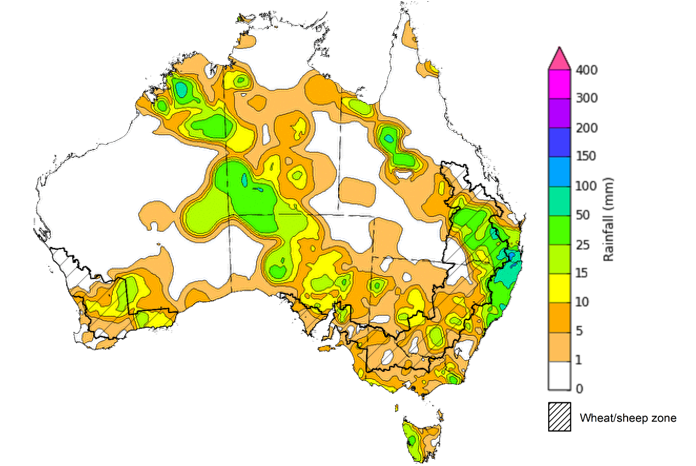
Issued: 13/11/2024
Note: The rainfall analyses and associated maps utilise data contained in the Bureau of Meteorology climate database, the Australian Data Archive for Meteorology (ADAM). The analyses are initially produced automatically from real-time data with limited quality control. They are intended to provide a general overview of rainfall across Australia as quickly as possible after the observations are received. For further information go to http://www.bom.gov.au/climate/rainfall/
Over the 8 days to 14 November 2024, low-pressure systems and troughs are expected to bring showers and storms across parts of northern Australia, extending into central and eastern parts of the country. Falls of between 5 and 50 millimetres of rainfall is forecast in eastern and southern Western Australia, the Northern Territory, South Australia and Tasmania. Lighter falls of between 5 and 25 millimetres are forecast for southern Victoria. Meanwhile, heavier falls of between 10 and 100 millimetres are forecast for the south-eastern Queensland and across eastern New South Wales. High pressure systems are expected to keep the remainder of the country largely dry.
Across cropping regions, rainfall totals are forecast to be relatively low across most southern growing regions. Much of southern New South Wales, Victoria, South Australia, and Western Australia are forecast to see rainfall totals of between 1 and 10 millimetres. In contrast, much of Queensland and northern New South Wales, are likely to see rainfall totals of between 10 and 50 millimetres.
If realised, high rainfall totals in the east could interrupt the harvest of winter crops. Little to no rainfall forecast across southern Australia will provide for an uninterrupted harvest of winter crops for grain and hay where harvest has commenced. In areas which did not receive rainfall last week, another dry week may see further declines in grain yields in later sown crops and farmers will be making decisions on whether to cut these crops for hay or turn them over for livestock grazing as grain yield and relative returns for grain compared to hay continue to decline.
Total forecast rainfall for the period 14 November to 21 November 2024
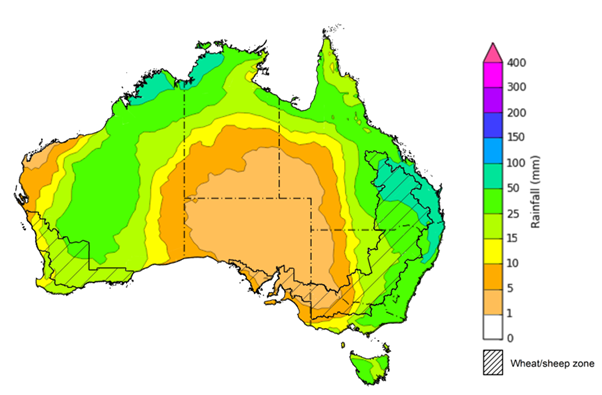
Issued 14/11/2024
Note: This rainfall forecast is produced from computer models. As the model outputs are not altered by weather forecasters, it is important to check local forecasts and warnings issued by the Bureau of Meteorology.
The El Niño Southern Oscillation (ENSO) and Indian Ocean Dipole (IOD) climate drivers are currently neutral and having minimal influence on Australian rainfall. The Southern Annular Mode (SAM) is currently positive, and is forecast to remain positive over the coming fortnight. Forecasts indicate it is likely to remaining in the positive phase in December. A positive SAM contributes to an increased change of rain in the summer months in the south-east of Australia.
The most recent rainfall outlook for December 2024 provided by the Bureau of Meteorology indicates that much of eastern Australia, including Queensland, eastern New South Wales, and western Victoria are likely to see above median rainfall (between 55 to 70% chance). There is a roughly equal probability of either above or below median rainfall across large areas of western, central and northern Australia. According to Bureau of Meteorology’s climate model, for December 2024, there is a 75% chance of rainfall totals of between 25 and 100 millimetres across much of eastern Queensland and New South Wales, and southern Victoria. Rainfall totals are likely to be higher in the north, with the northern tropics likely to receive between 100 and 200 millimetres of rainfall over the period, with isolated areas in the far-north of the Northern Territory and Queensland seeing as much as 300 millimetres. In contrast, much of western and central Australia is likely to receive little to no rainfall. Meanwhile, Tasmania is forecast to receive between 50 and 200 millimetres of rainfall.
Across cropping regions, there is a 75% chance of receiving between 50 and 100 millimetres of rainfall across much of Queensland and New South Wales in December 2024, with higher rainfall totals expected in eastern regions. In South Australia, Victoria and eastern Western Australia, rainfall totals are expected to be between 10 and 25 millimetres. These relatively low expected rainfall totals across much of southern Australia continue to represent a significant downside risk for pasture growth over summer, particularly given the lack of rainfall in recent weeks and declining soil moisture levels across large areas. However, if forecast rainfall totals are realised across much of New South Wales and Queensland, these falls are likely to be sufficient to support above average yield prospects for summer crops and average or better levels of pasture production.
Rainfall totals that have a 75% chance of occurring in December 2024
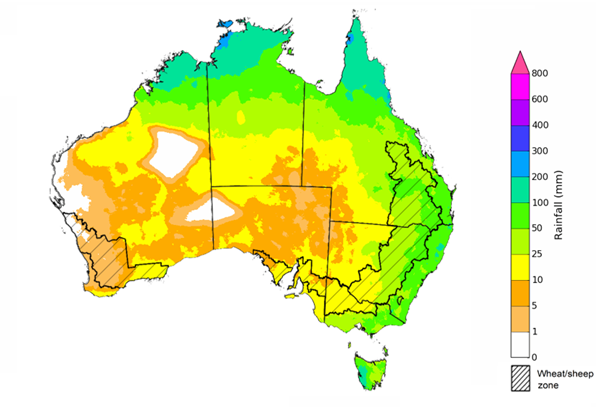
Issued: 14/11/2024
The rainfall outlook for December 2024 to February 2025 indicates an increased probability of above average rainfall across large areas of eastern Australia. In contrast, below median rainfall is slightly more likely across isolated areas of Western Australia and the Northern Territory. Much of the remainder of the country is showing an equal probability of above or below median rainfall.
Across cropping regions, the chance of receiving above median rainfall is between 55% to 75% across much of Queensland, New South Wales, and Victoria. In South Australia and Western Australia, the chances of receiving above median rainfall are between 45% and 60% across most areas, with exceptions in isolated areas of Western Australia with a 35% chance of above median rainfall.
Chance of exceeding the median rainfall December 2024 to February 2025
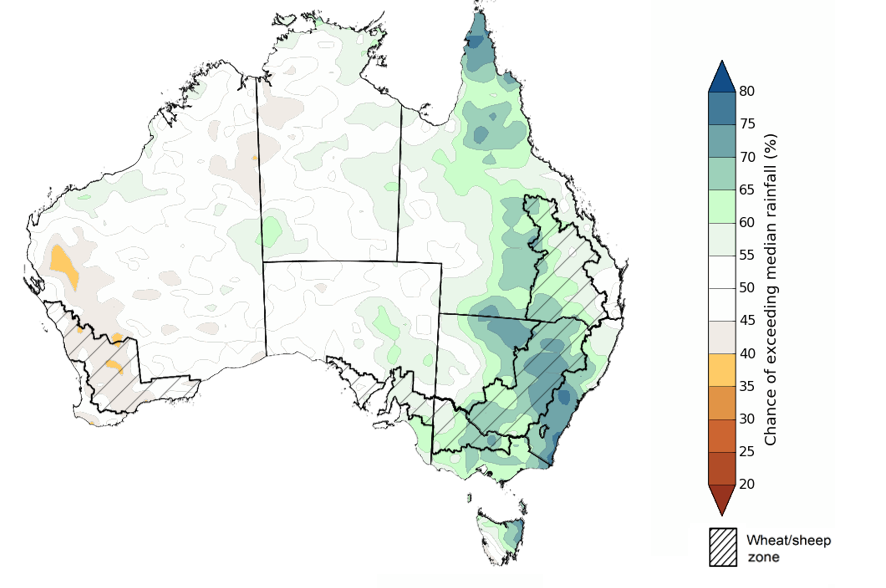
Issued: 14/11/2024
The outlook for December through to February suggests a 75% chance of receiving rainfall totals of between 50 and 300 millimetres across much of Queensland, New South Wales, Victoria, Tasmania, and the Northern Territory. Rainfall totals in excess of 300 millimetres are forecast for the tropical north of Western Australia, the Northern Territory, and Queensland, as well as coastal areas of Queensland and New South Wales and western Tasmania. Western and central Australia are likely to receive rainfall totals of between 10 and 50 millimetres over this period.
In summer cropping regions, there is a 75% chance of receiving between 100 and 300 millimetres of rainfall across much of Queensland and New South Wales. If these forecast rainfall totals for the December through to February period are realised, they are likely to be sufficient to support summer pasture growth across eastern and northern Australia. Additionally, these expected falls are likely to be sufficient to boost soil moisture profiles and maintain above yield expectation for summer crops in Queensland and northern New South Wales.
Rainfall totals that have a 75% chance of occurring December 2024 to February 2025
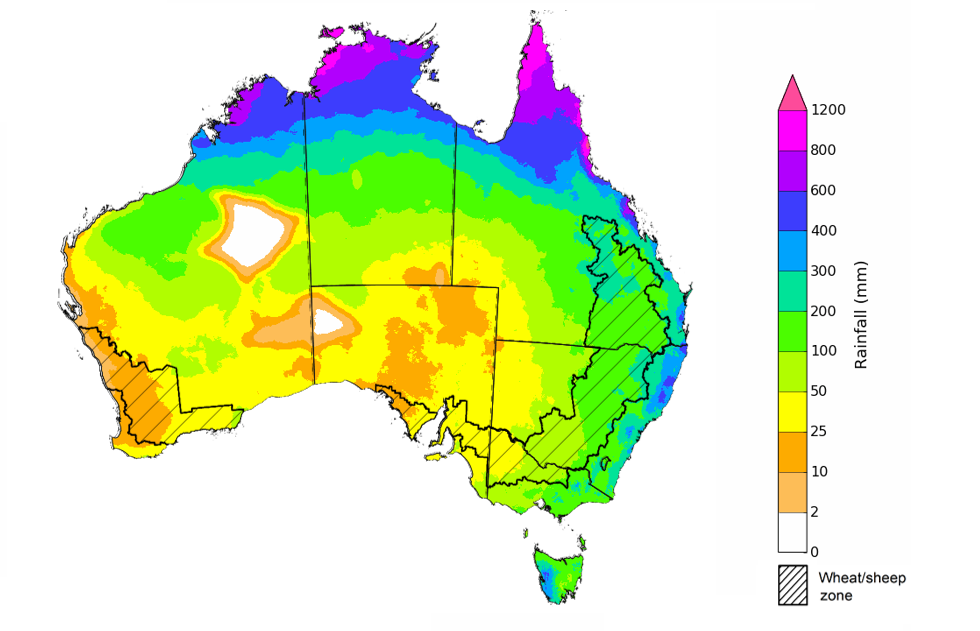
Issued: 14/11/2024
Water
Water storages, water markets and water allocations - current week
The Tableau dashboard may not meet accessibility requirements. For information about the contents of these dashboards contact ABARES.
Commodities
Information on weekly price changes in agricultural commodities is now available at the Weekly commodity price update.
